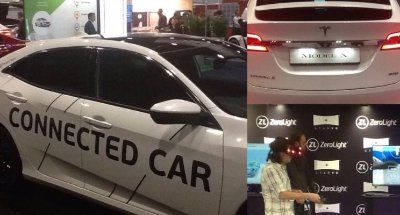Imagine cruising through Texas at 200 miles per hour.
Get the latest international news and world events from around the world.



French President Macron launches tech visa to make France a ‘country of unicorns’
France launched a technology visa on Thursday which aims to attract international talent, with newly-elected President Emmanuel Macron talking about the need to strip out regulation to become a “country of unicorns”.
Speaking at the Viva Tech conference in Paris, France, Macron outlined how his government would slash complex regulation, make it easier for foreign talent to work, and support start-ups with money, in order to create world-leading companies.
The visa is open to start-up founders, employees and investors and is a fast-track procedure to obtain a residence permit in France known as the “Talent Passport”. It’s valid for four years and extended to immediate family members.

Earlier this week, I interviewed on TV2, one of Hungary’s most popular channels w/ about a million viewers
The story is on bringing people back to life with radical science and it talks about transhumanism and cryonics. This is the most widespread story I’ve seen on #transhumanism in Eastern Europe yet. https://tenyek.hu/kulfold/237876_felelesztik-az-agyhalottakat.html

Tech Giant (FANG) Valuations, Bitcoin –London Tech Week
https://www.linkedin.com/pulse/tech-giant-fang-valuations-bi…ett-gallie on @LinkedIn
Investopedia defines the FANG stocks as : “FANG is the acronym for four high performing technology stocks in the market as of 2017 – Facebook, Amazon, Netflix, and Google (now Alphabet, Inc.).” http://www.investopedia.com/terms/f/fang-stocks-fb-amzn.asp
After this week’s FANG selloff and Bitcoin’s drop from $3,000 we scanned the media for the reasons for the drop.
Does the price of Bitcoin move in correlation to the FANG stocks?

A NASA rocket is going to blast colored clouds into space — here’s how to see them
Sat 17 June…NASA rocket to blast colored clouds into space…similar to our 2017 SpaceApps Groups Idea : https://2017.spaceappschallenge.org/challenges/warning-dange…er/project
- NASA is launching a rocket that will create colorful clouds in space.
- The rocket launch and clouds may be visible as far away as New York City.
- Such clouds will eventually be used to probe two big holes in Earth’s magnetic shield, called cusps.
- The launch will be live-streamed by NASA Wallops Flight Facility.
NASA is about to launch a rocket that will puff out highly visible clouds of red and blue-green vapor into space.
The rocket was supposed to launch on May 31, but bad weather and poor visibility pushed the mission back to Saturday, June 17, with a liftoff time between 9:05 p.m. and 9:20 p.m. EDT.
LEAF Panel: How to Promote Longevity? ft. Drs. Aubrey de Grey, Alexandra Stolzing, Oliver Medvedik
On the 9th of June we teamed up with the Major Mouse Testing Program (MMTP) for a live stream longevity panel on the MMTP Facebook page. The panel included Dr. Alexandra Stolzing, Dr. Aubrey de Grey, Dr. Oliver Medvedik, MMTP coordinators Steve Hill and Elena Milova, Lifespan.io President Keith Comito, and one of the most active contributors Alen Akhabaev. The event was one of the rewards from the MMTP campaign launched on Lifespan.io last year.
During the first section the panelists discuss the science and progress in the field, touching upon senescent cell therapy with senolytics, its progress and limitations, stem cells therapies and other promising interventions to slow down and potentially reverse age-related damage to health.
The second section moves to the discussion of the existing bottlenecks in advocacy, and what the members of the community can do to promote and popularize rejuvenation biotechnology among the general public more effectively.


When artificial intelligence is bad news for the boss
The two academic authors from Massachusetts Institute of Technology, who became the pin-up boys of the Davos crowd for their previous book on The Second Machine Age (2014), do a neat job of scanning the technological horizon and highlighting significant landmarks. This is a clear and crisply written account of machine intelligence, big data and the sharing economy. But McAfee and Brynjolfsson also wisely acknowledge the limitations of their futurology and avoid over-simplification. No one can really have much idea how the business world is going to evolve or predict the precise interplay between all these fast-changing forces.
A new book by the authors of ‘The Second Machine Age’ suggests that digital disruption is coming to the corner office.